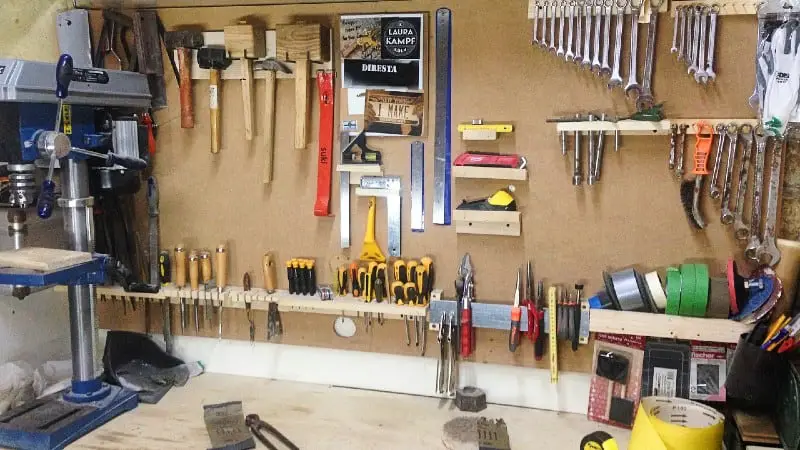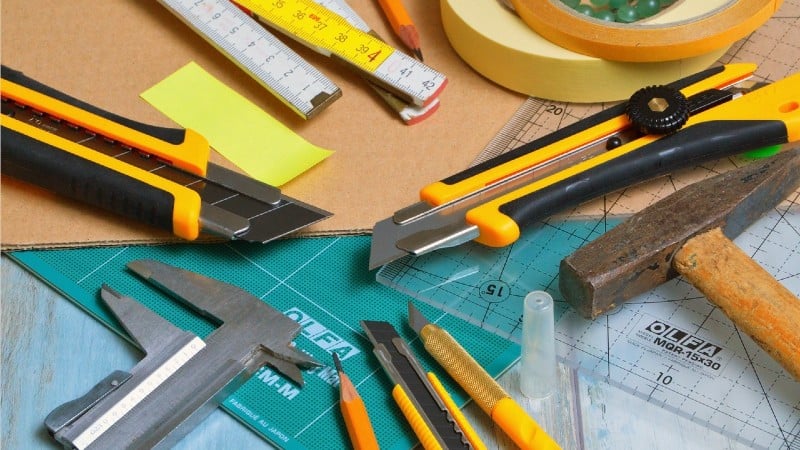Woodworking is a hobby that can be fun and therapeutic for many people. But we all have moments where we feel like throwing screwdrivers at things out of frustration.
To help make your next project a little more enjoyable, here are some tips to help keep you sane in the workshop:
- Read the directions through from start to finish before you start. This will give you an idea of what’s involved and also avoid any surprises later on.
- Measure twice, cut once. Your project will go much faster if you don’t have to re-cut wood because it was too short or long. And it will save your sanity when it’s time to assemble everything!
- Learn how to finish wood properly and don’t rush the job. Finishing is a very important part of any project and can make or break your efforts in minutes if you’re not thorough enough, or rush it too much.
The above are just some of the helpful tips shared in this article—be sure to read on for more great ideas as well!
Table of Contents
- Tip #1 – Plan Your Project: 10 Best Tips To Make Woodworking Projects Less Stressful
- Tip #2 – Set Goals Every Day
- Tip #3 – Many Hands Make Light Work.
- Tip #4 – Let Your Tools Do the Heavy Lifting.
- Tip #5 – Stay Organized.
- Tip #6 – Be Prepared for Mistakes.
- Tip #7 – Learn a Little Every Day.
- Tip #8 – Take the Time to Clean Up When You’re Done Working.
- Tip #9 – Use the Right Tools for the Job.
- Tip #10 – Being well organized and having a good plan will make your woodworking projects more fun and less stressful.
- Final Words: 10 Best Tips To Make Woodworking Projects Less Stressful
Tip #1 – Plan Your Project: 10 Best Tips To Make Woodworking Projects Less Stressful
Planning is a crucial step when beginning any project, but especially with woodworking. Because of the complexity, a plan can save you time and money. For any woodworking project, you should do these three things:
- Decide what type of wood you want to use. This will depend on the size and purpose of your project. Different types of wood have different strengths and weaknesses that can affect how well your final product turns out.
- Plan for the tools needed to complete your project. Some projects can be completed using all hand tools, but if you have access to power tools, they may make some steps quicker and easier.
- You know what’s not fun? Realizing that the piece of lumber you just cut doesn’t fit or look like what it was supposed to. So, before you start cutting into anything of value, make sure you have a rough sketch of your project so you know where all the pieces will go! I wrote another article about planning and the tools needed for a workbench.

Tip #2 – Set Goals Every Day
To keep things moving along and make sure you’re getting everything done, it helps to set goals every day. To do this you need to get a good night’s sleep so you can start your day refreshed. It also helps to plan ahead and look at what you have to do the next day or even the next week. By planning ahead you can form a routine that will help you stay focused and on track throughout the day.
As far as setting goals go, try not to get stuck on one task for too long if there are other things that need your immediate attention. Managing your time well is essential so that everything gets done when it needs to be done.
To make sure that your goals remain top of mind throughout the day, write them down on a piece of paper (or use an app like Google Keep). Make sure you also cross off each item as it is completed so that you can keep track of how much has been accomplished and what remains to be done.
Tip #3 – Many Hands Make Light Work.
As a DIY-er, you may have the inclination to do everything yourself. But trust me, you can also benefit from having a partner or two help you with your woodworking projects. For starters, it’s more fun to work with someone else and less stressful—especially if it’s a partner who shares your passion for DIY. You can use this opportunity to learn new skills from one another and even get some good advice on how to proceed with your project when you encounter problems or obstacles along the way.
But most importantly, having a helping hand will lighten the workload of both of you (or all three of you!), especially in terms of physical labor. After all, there are only so many hours in a day and only so much energy we can expend before needing to recharge! Do you want a break from the work in your shop? I wrote another article about humorous woodworking song lyrics.

Tip #4 – Let Your Tools Do the Heavy Lifting.
Forget sawing. Let your tools do the heavy lifting for you. Here are some of the most useful woodworking machines out there:
Bandsaw – Bandsaws are great for cutting irregular shapes in any direction and making curved cuts. They’re also great for cutting thicker pieces of wood, easily slicing through logs and other materials that might be too thick for a table saw.
Table Saw – The table saw is an excellent tool for making straight cuts. It is also a common source of injuries among amateur woodworkers, so please be careful while using it!
Sander – This tool is used to smooth out rough edges and get rid of imperfections in your workpiece.
Router – A router is a versatile machine that can help you make clean cuts and grooves in your workpiece by spinning a bit against the surface of the wood at high speeds.
Jigsaw – A jigsaw is a tool that can be used for cutting out shapes in wood, plastic, or metal. The blade of the saw moves up and down rapidly.
Lathe – A lathe is used when the goal is to create a cylindrical piece of wood.
Drill – Holes are essential parts of many projects. So, instead of using a hand drill, use a power drill to get your holes done in no time.
Drill Press – With a drill press, you can drill holes into the wood much faster and more consistently than with an ordinary drill.
Drum Sander – This is a type of sander that uses a cylindrical abrasive surface to help you get the precise smooth texture you’re looking for. These are often available as accessories for Drills and Drill Presses.
Thickness Planer – This is a machine designed to help you get your boards to the exact thickness you need for whatever project you’re working on. If it’s too thick and unwieldy, the thickness planer will make it more manageable in no time.
Tip #5 – Stay Organized.
Create a workspace that is suited to the woodworking you do. Staying organized will help save time, keep your focus, and allow you to finish projects more efficiently.
Don’t let clutter around your workshop distract from finishing a project in progress, or keep you from starting a new one. That would be an added source of stress! A messy shop can also cause accident-prone situations, so clear the floor of tools and sweep up the sawdust when you are finished for the day. Additionally, put tools away where they belong once finished using them so they’re ready to use again next time.
Having enough space is another key component to staying organized while working on a project in your workshop environment. The last thing you want or need is to have limited space which makes it harder for you to work on a project. This can easily become frustrating and cause delays because there isn’t ample room for bigger projects that require larger work surfaces and adequate storage space for materials needed for specific woodworking tasks such as cutting wood, sanding millwork or gluing parts together. Are you organized enough to start your own business? In another article, I show how to find woodworking crafts that sell.

Tip #6 – Be Prepared for Mistakes.
Every woodworker will tell you the same thing: mistakes are part of woodworking. No matter how great your skills are, an inevitable mistake will occur at some point in your life as a woodworker. These mistakes can be anything from dropping a tool on your feet to mismeasuring a piece of timber.
What’s important is that you must prepare for these mistakes before they happen. You cannot expect things to go perfectly all the time.
The best way to prepare for errors is to have extra materials on hand. It doesn’t matter if you have plenty of experience under your belt; if you run out of materials mid-project and don’t have any extras it could be disastrous! So make sure you always have spare lumber and hardware lying around — it can save your project in a pinch or even inspire new ideas when you see something unexpected!
Tip #7 – Learn a Little Every Day.
One of the greatest resources you have available to you is right at your fingertips. The internet, with all its massive amounts of information, allows you to learn more about woodworking than ever before.
If you are a novice, find an online forum or a community college class that will help give you more knowledge and confidence in your craft.
If there is not an online community dedicated to your craft and local classes are not available, try reaching out to friends and family that may know something about woodworking. A good friend or relative would probably be happy to teach you a few things about their hobby and give you some tips on how to get started!
Read up on woodworking as much as possible before starting on your project. There are many different types of wood, which means there’s also an endless amount of ways to use them in your own unique style. The more knowledge you have about this material, the better prepared you’ll be for any challenges that come your way during construction! In another article, I give 11 benefits of woodworking as a hobby.

Tip #8 – Take the Time to Clean Up When You’re Done Working.
When it comes to woodworking, a little clean-up can go a long way toward keeping your projects fun and stress-free. Many people overlook the importance of cleaning up their work area after they’re done working for the day, but it pays off in the long run!
A clean workshop is safer and more comfortable, which can help you be more productive in future work sessions. You’ll be able to find your tools and supplies faster without clutter in the way, and you’ll know that you’ve put everything back where it belongs. It’s also a good idea to make sure your space is well-lit. This helps prevent injuries that could occur if you don’t see where you’re going.
Not only will a clean work area help you feel less overwhelmed with all of your projects, but it’s also a fun way to end your day. You’ll feel like you’ve accomplished something—even if you didn’t get any actual woodworking done—and start the next day off feeling motivated and energized!
Tip #9 – Use the Right Tools for the Job.
One of the most common mistakes that people make when they are new to woodworking is using the wrong tool for a particular job. For example, you don’t want to use a saw when a screwdriver will do, and you don’t want to use a chisel when what you really need is a gouge. Using the wrong tool, or trying to improvise with the one that you have but is not specifically designed for your project can be frustrating and even dangerous.
Instead of just grabbing any old tool from your collection and hoping for the best, consider what it is that you are trying to accomplish before picking up anything. Do some research online about how various tools are used in woodworking projects. After all, there may be something in your arsenal that sounds like it should work but actually won’t do what you need it to do.
Woodworking is hard enough at times. You don’t need to make it harder by not having all the right tools at hand. So go ahead and take a minute before you start your project to make sure you have everything you need. It won’t take too long and your stress levels will thank you for it! One popular tool is the jigsaw. In another article, I give 31 helpful tips for woodworking with this tool.

Tip #10 – Being well organized and having a good plan will make your woodworking projects more fun and less stressful.
First of all, get organized before you start building your project. You’ll need to have a plan that lays out all the steps so that you don’t run into any unexpected problems or delays during the process. This will help keep your stress down and prevent unnecessary mistakes.
Second, keep your tools organized and clean up after yourself as much as possible. This will contribute towards a less stressful experience for everyone involved because no one likes working in clutter or messes.
And thirdly, don’t be afraid to ask for help! If there’s someone nearby who has experience with woodworking projects or just wants to lend their expertise, then let them help!
Fourthly, remember that mistakes happen when learning new skills like this one so if something doesn’t go exactly according to plan – don’t worry too much about it! Mistakes are how we learn and grow; no one knows everything or does everything perfectly the first time around, so be kind to yourself when you don’t get it right on your first try.
Fifth, It’s okay to take breaks! Don’t forget that this is supposed to be fun too! If you’re feeling frustrated or exhausted, give yourself some time to chill out, sleep on it, or go for a walk. The world will still be there when you come back!
Final Words: 10 Best Tips To Make Woodworking Projects Less Stressful
In conclusion, let’s review some of the best tips to make your woodworking projects less stressful:
- Plan your project.
- Set daily goals.
- Get the help of others.
- Let tools do the hard work
- Be organized
- Be prepared for mistakes. It’s all part of learning more about woodworking!
- Learn something new every day—it keeps you motivated and improves your mood!
- Clean up when you’re done working
- Use the right tools for the job
- Enjoy your work
No matter the project, you can make woodworking a less stressful and more enjoyable experience. So try these ten tips for yourself and see how much happier you are with your work!
Did you enjoy reading this article? If you, you might like my Pinterest profile. It contains pins about Woodworking, Tools, Projects, Hardware, Diy & Crafts, and many other topics!

